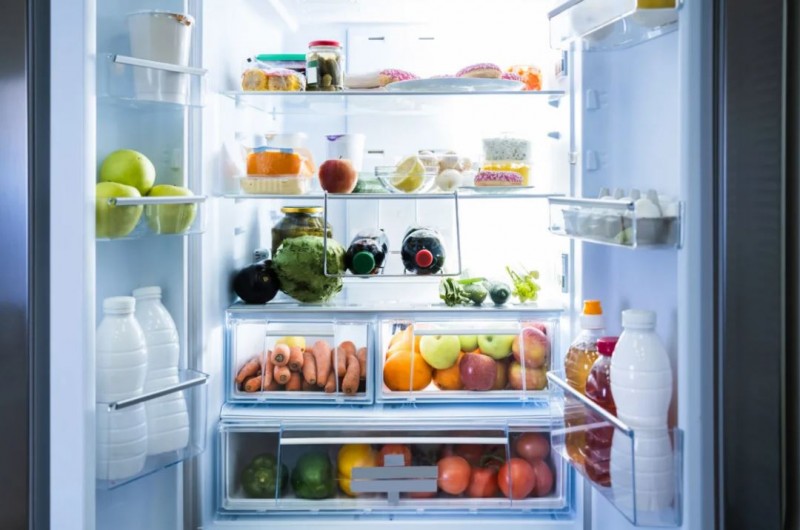
The refrigerator is a crucial appliance for keeping fruits, vegetables, and other foods fresh for extended periods. However, negligence on our part can lead to spoilage of some vegetables and a loss of freshness in stored items. To avoid such situations, we present 10 tips that will help you keep fruits, vegetables, and food fresh for longer durations while preserving their natural flavors.
Properly Prepare Fruits and Vegetables for Refrigeration:
Before placing fruits and vegetables in the refrigerator, it's crucial to ensure they are adequately prepared to maximize their shelf life. This involves:
a. Washing and Drying: Thoroughly wash fruits and vegetables under running water to remove dirt, pesticides, and contaminants. After washing, allow them to air dry completely or use a clean towel to pat them dry. Moisture on the surface of produce can promote mold and spoilage, so it's essential to ensure they are dry before refrigeration.
b. Trimming and Cutting: Trim any bruised or damaged areas on fruits and vegetables before refrigerating them. Additionally, consider cutting larger items into smaller pieces if necessary, as this can help facilitate airflow and prevent overcrowding in the refrigerator, thereby maintaining optimal freshness.
Optimal Storage Conditions:
Proper storage conditions play a significant role in preserving the freshness and quality of fruits and vegetables in the refrigerator. Follow these guidelines for optimal storage:
a. Temperature Settings: Set your refrigerator to the ideal temperature range for storing fruits and vegetables, typically between 35°F to 40°F (1.7°C to 4.4°C). Temperatures lower than this range can cause chilling injuries, while higher temperatures can accelerate spoilage.
b. Humidity Control: Some fruits and vegetables require specific humidity levels for optimal storage. Use the humidity control settings in your refrigerator's crisper drawers to regulate moisture levels. High humidity is suitable for leafy greens, herbs, and berries, while low humidity is ideal for fruits like apples and pears.
c. Ethylene Management: Ethylene is a natural ripening hormone produced by certain fruits and vegetables, which can accelerate ripening and spoilage in sensitive produce. Keep ethylene-producing fruits like bananas, apples, and avocados separate from ethylene-sensitive items like leafy greens and berries to prevent premature ripening.
Minimize Temperature Fluctuations:
Fluctuations in temperature inside the refrigerator can adversely affect the shelf life and quality of stored fruits and vegetables. To minimize temperature fluctuations:
a. Avoid Overloading: Overcrowding the refrigerator can impede airflow and lead to uneven temperature distribution. Arrange fruits and vegetables in a way that allows for adequate airflow between items to ensure uniform cooling.
b. Limit Door Openings: Limit the frequency and duration of opening the refrigerator door to prevent warm air from entering and causing temperature fluctuations. Plan ahead and retrieve all necessary items in a single opening to minimize heat exposure.
c. Avoid Placing Hot Foods: Avoid placing hot or warm foods directly into the refrigerator, as this can raise the internal temperature and cause other items to spoil prematurely. Allow hot foods to cool to room temperature before refrigerating them.
Regular Maintenance and Cleaning:
Regular maintenance and cleaning of the refrigerator are essential for ensuring optimal performance and food safety. Follow these maintenance tips:
a. Clean Spills Promptly: Immediately clean up any spills or leaks inside the refrigerator to prevent the growth of bacteria and mold. Use a mild detergent and warm water to wipe down shelves, drawers, and walls regularly.
b. Check and Replace Seals: Inspect the door seals or gaskets regularly for signs of wear or damage. Damaged seals can allow warm air to enter the refrigerator, leading to temperature fluctuations and increased energy consumption. Replace worn-out seals promptly to maintain a tight seal.
c. Monitor Temperature: Periodically check the temperature of the refrigerator using a thermometer to ensure it remains within the recommended range. Adjust the temperature settings as needed to maintain optimal conditions for storing fruits and vegetables.
Ethylene Management:
As mentioned earlier, ethylene is a natural ripening hormone produced by certain fruits and vegetables. To effectively manage ethylene levels:
a. Separate Ethylene Producers: Store ethylene-producing fruits such as bananas, apples, and tomatoes separately from ethylene-sensitive items like leafy greens, broccoli, and carrots. This prevents premature ripening and extends the shelf life of sensitive produce.
b. Use Ethylene Absorbers: Consider using ethylene-absorbing products such as activated charcoal or ethylene-absorbing sachets to absorb excess ethylene in the refrigerator. These products help prolong the freshness of fruits and vegetables by reducing ethylene exposure.
By following the comprehensive strategies and tips outlined in this guide, you can effectively preserve the freshness and quality of fruits and vegetables stored in your refrigerator for extended periods. Proper preparation, optimal storage conditions, minimizing temperature fluctuations, regular maintenance, and ethylene management are key factors in ensuring the longevity of your produce. Incorporate these practices into your routine to enjoy fresh and nutritious fruits and vegetables for longer durations.
Start Your Day Desi-Style: 10 Weight-Loss Friendly Indian Breakfast Ideas
How to Build Strong Muscles through Yoga: Essential Poses for Strength, Resilience
How to Make Alia Bhatt's Favorite Salad for Radiant Health, Weight Management, and More!